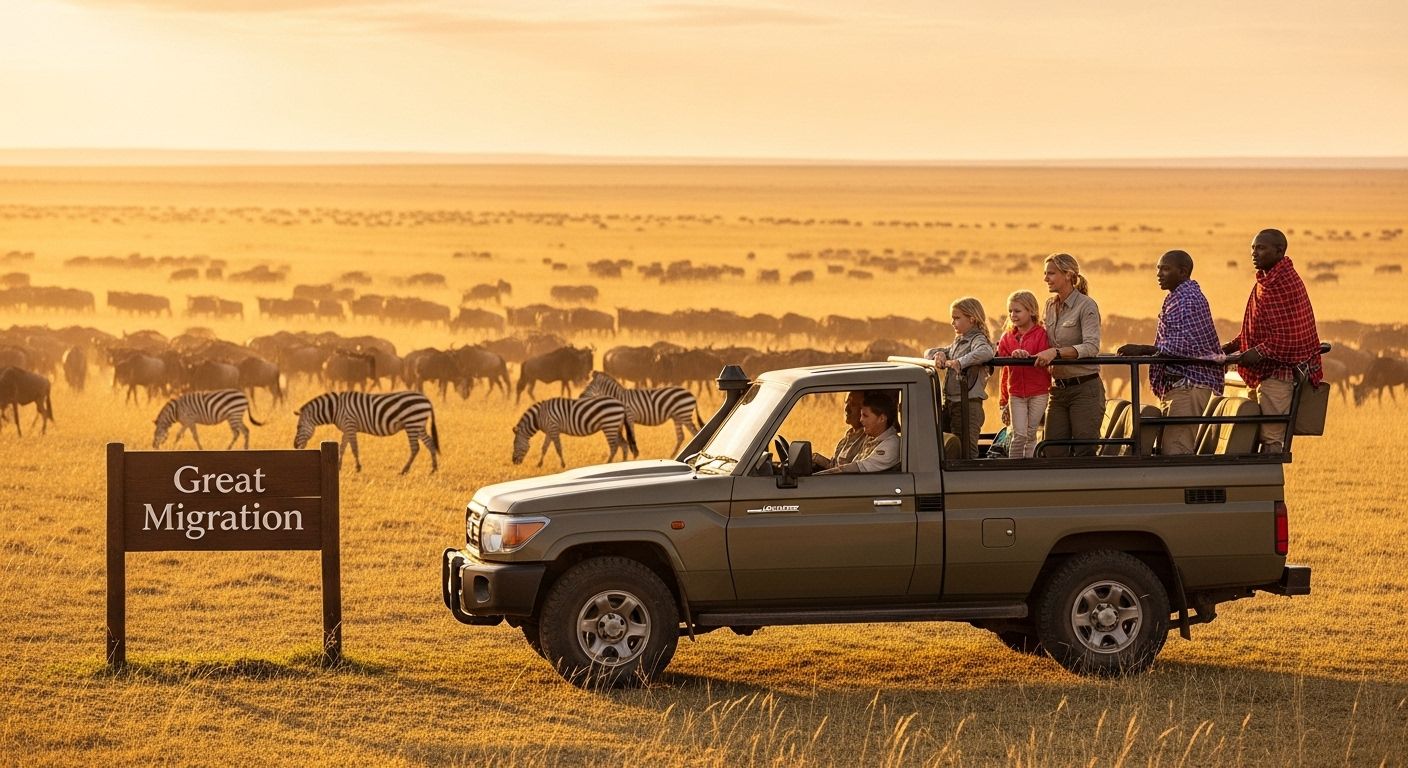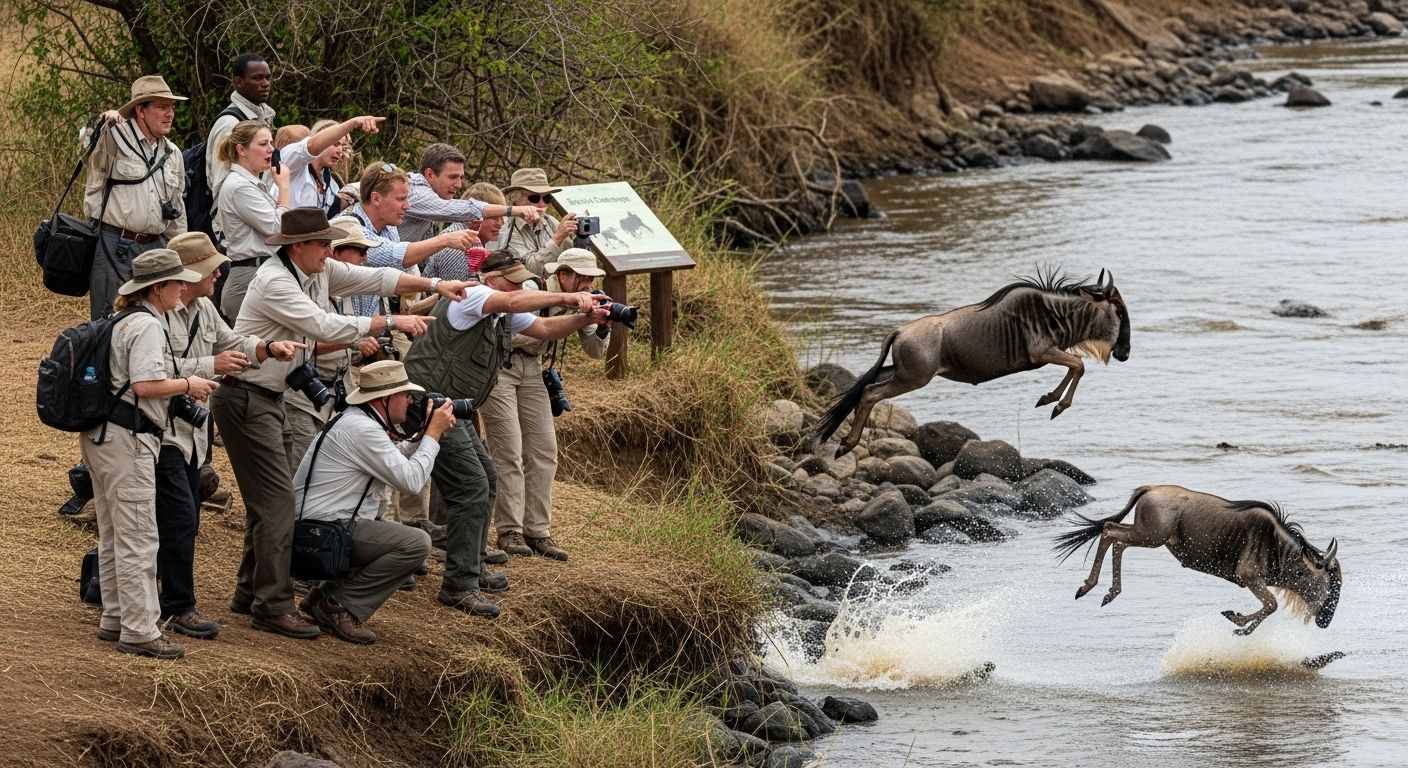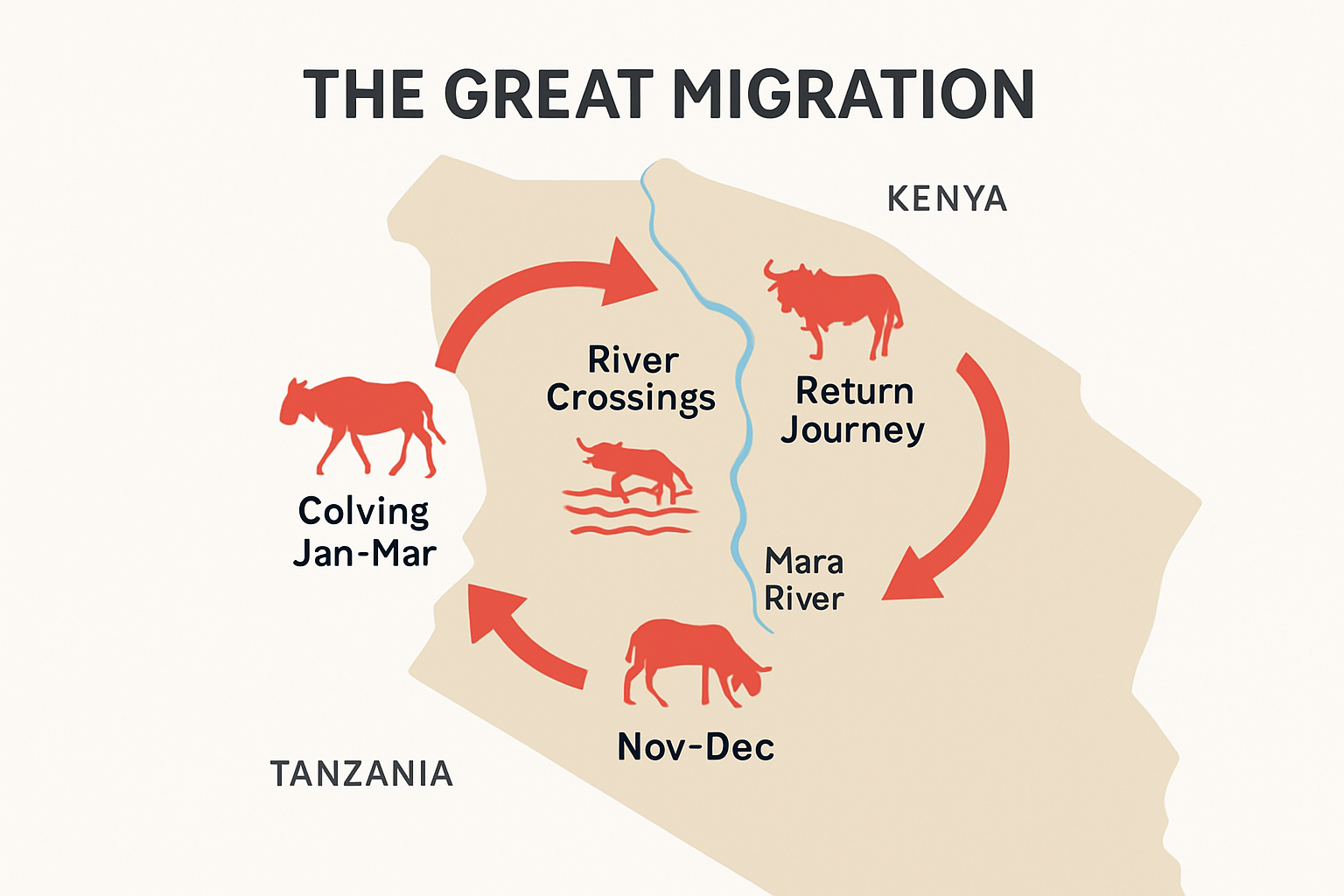What Is the Great Migration? Your Guide to Africa’s Iconic Wildlife Journey
Full Disclosure: Our AI Assistant Writes These!
While we're out in the bush tracking leopards, dodging elephants, and trying to get the perfect sunset shot, our trusty AI companion is back at camp, diligently crafting these blog posts. Don't worry though - it's been trained on years of real safari experiences and only occasionally suggests that tourists should pet the lions. (Please don't pet the lions. The AI was joking. We hope.)
The real reason? SEO loves fresh content, and we love fresh adventures. So while our AI handles the keywords and search rankings, we're out there finding the next hidden waterhole, secret viewpoint, or that one tree where the leopards always hang out. Win-win, really!
What Is the Great Migration? Your Guide to Africa’s Iconic Wildlife Journey

Every year, the plains of East Africa come alive with a jaw-dropping spectacle as millions of animals surge across the Serengeti and Maasai Mara. Most people think it’s just about spotting huge herds on endless grasslands. But what really sets the Great Migration apart is the scale and drama. Around 1.5 million wildebeest and over 500,000 zebras and gazelles make a 1,200-mile circuit, braving hungry predators and treacherous river crossings. The battles for survival and the thrill of the chase turn each moment into a true-life wildlife documentary, happening all around you.
Table of Contents
- Understanding What Is The Great Migration
- When And Where Does The Migration Happen
- Best Ways To Experience The Great Migration
- Essential Tips For All Types Of Travellers
Quick Summary
| Takeaway | Explanation |
|---|---|
| Experience the Great Migration in July to October. | This period has dramatic river crossings, making it ideal for witnessing the spectacle. |
| Consider mobile camps for immersive experiences. | Mobile camps follow the herds, offering a closer view of the migration dynamics. |
| Book your safari well in advance. | Due to high demand during peak migration, securing accommodations early is crucial. |
| Respect wildlife viewing guidelines. | Following these guidelines ensures safety for both animals and travelers while supporting conservation. |
| Prepare for variable weather conditions. | Pack appropriate clothing and gear to adapt to the unpredictable climate in East Africa. |
Understanding What Is the Great Migration
The Great Migration represents one of the most remarkable wildlife phenomena on our planet, an annual journey that captures the imagination of wildlife enthusiasts and nature lovers worldwide. This extraordinary event involves massive herds of wildebeest, zebras, and gazelles traversing the expansive grasslands of East Africa in a continuous cycle of survival and renewal.
The Essence of Nature’s Greatest Journey
At its core, the Great Migration is a massive circular movement of approximately 1.5 million wildebeest and hundreds of thousands of other animals across the Serengeti ecosystem. According to National Geographic, this annual trek covers nearly 1,200 miles, representing one of the most significant wildlife movements on Earth. The migration is driven by fundamental survival instincts search of fresh grazing lands and water sources, creating a continuous cycle that has been repeated for thousands of years.
The journey is not just a simple movement but a complex ecological ballet that involves multiple species and intricate environmental interactions. Wildebeest form the primary participants, but zebras and gazelles also play crucial roles in this remarkable annual pilgrimage. Their synchronized movement is a testament to the incredible adaptability and resilience of wildlife in responding to seasonal changes.
Survival Against Extraordinary Challenges
The migration is fraught with incredible challenges that test the limits of animal endurance. During their journey, these herds must navigate treacherous river crossings, survive predator attacks, and endure extreme environmental conditions. African Wildlife Foundation notes that these crossings are particularly dangerous, with crocodiles waiting to ambush animals as they attempt to swim across rivers like the Mara River.
Predators such as lions, cheetahs, and hyenas view the migration as an extraordinary feeding opportunity. The constant movement creates a dynamic ecosystem where survival depends on speed, strategy, and collective herd behavior.
Young animals must keep pace with the moving herds, while older and weaker individuals face significant risks.

The Great Migration is more than just an animal movement it is a complex ecological system that sustains entire ecosystems. Each animal plays a critical role in maintaining the delicate balance of the grasslands, demonstrating how interconnected and sophisticated natural systems can be. Their journey represents not just survival, but a profound example of nature’s incredible adaptability and resilience.
For wildlife enthusiasts and travelers, understanding the Great Migration offers a glimpse into one of the most spectacular natural events on our planet. It is a reminder of the incredible complexity of wildlife systems and the ongoing struggle for survival in some of the world’s most challenging environments.
When and Where Does the Migration Happen
The Great Migration is a complex annual journey that unfolds across an expansive and dynamic landscape, transforming the ecosystems of East Africa through a carefully choreographed movement of millions of animals. Understanding the precise timing and geographical details of this extraordinary phenomenon provides insight into one of nature’s most remarkable spectacles.
The Geographic Scope of Movement
The migration spans two primary countries in East Africa: Tanzania and Kenya, specifically traversing the Serengeti National Park and the Maasai Mara National Reserve. Smithsonian Magazine reports that this incredible journey covers approximately 1,200 miles annually, representing the largest terrestrial mammal migration on the planet. The herds move in a continuous circular route, following ancient pathways dictated by rainfall patterns and the availability of nutritious grasslands.
The ecosystem supporting this migration is not just a simple grassland but a complex network of interconnected habitats. Wildebeest, zebras, and gazelles navigate through varied terrains including open plains, woodland edges, and treacherous river crossings. These transitions are critical for survival, with each landscape offering different challenges and opportunities for the migrating herds.
Seasonal Timing of the Great Migration
The migration follows a remarkably consistent annual cycle, synchronized with seasonal rainfall and grass growth. According to National Geographic, the migration’s rhythm can be broadly divided into several key phases:
- December to March: Calving season in the southern Serengeti, where approximately 500,000 wildebeest calves are born
- April to June: Herds begin moving northwest across the Serengeti
- July to October: Peak crossing period, with dramatic river crossings into Kenya’s Maasai Mara
- November: Herds start returning south as the rains begin in Tanzania
These movements are not rigid but fluid, adapting to subtle environmental changes. Rainfall patterns can shift the timing by weeks or even months, demonstrating the migration’s dynamic nature. Predators like lions, cheetahs, and crocodiles have evolved to anticipate and take advantage of these predictable movements.
To help you plan your safari around the Great Migration, here’s an overview of the main migration phases, the timing, and what you can expect to see during each period:
| Migration Phase | When | Main Locations | Key Events/Highlights |
|---|---|---|---|
| Calving Season | Dec - Mar | Southern Serengeti | Wildebeest calves are born; predator action |
| North-western Movement | Apr - Jun | Serengeti (heading northwest) | Herds move towards fresher grazing lands |
| River Crossing Peak | Jul - Oct | Mara River, Serengeti, Maasai Mara | Dramatic river crossings; predator encounters |
| Southward Return | Nov | Serengeti (moving south) | Herds return as rains begin in Tanzania |

For wildlife enthusiasts planning to witness this incredible event, timing is crucial. Read our detailed guide on planning the perfect migration safari to maximize your chances of experiencing this natural wonder.
The Great Migration is more than a simple movement of animals it is a testament to the resilience and interconnectedness of natural ecosystems. Each journey represents a delicate balance of survival, adaptation, and the continuous renewal of life in one of the world’s most remarkable wilderness areas.
Best Ways to Experience the Great Migration
Witnessing the Great Migration is a once-in-a-lifetime experience that offers travelers an unprecedented glimpse into one of nature’s most spectacular wildlife events. Planning your journey requires careful consideration of timing, location, and the type of safari experience that best suits your interests and budget.
Safari Options for Migration Viewing
There are multiple approaches to experiencing the Great Migration, each offering a unique perspective on this extraordinary natural phenomenon. African Wildlife Foundation recommends several primary viewing strategies that cater to different traveler preferences.
Below is a comparison of popular safari options for experiencing the Great Migration to help you choose the approach that best matches your travel style and interests:
| Safari Option | Features | Best For |
|---|---|---|
| Game Drive | Guided vehicle tours along migration routes; close-up wildlife views | Classic safari lovers |
| Mobile Camp | Camps move with herds; frontline views of action | Immersive, close-to-action seekers |
| Hot Air Balloon | Early morning aerial views over herds and landscape | Unique perspectives, photographers |
| Luxury Lodge | Comfortable fixed camps, amenities, guided activities | Travellers seeking luxury and relaxation |
Game drive safaris remain the most popular option, allowing visitors to explore the migration routes in specially designed vehicles with experienced guides. These drives provide close-up views of the massive herds, capturing their incredible movement across the Serengeti and Maasai Mara landscapes. Professional guides can position vehicles at strategic locations to witness dramatic river crossings and predator interactions.
For more adventurous travelers, hot air balloon safaris offer an unparalleled aerial perspective of the migration. National Geographic notes that these early morning flights provide breathtaking panoramic views of millions of animals moving across the vast grasslands, creating a truly immersive wildlife experience.
Choosing the Right Time and Location
Timing is crucial when planning a Great Migration safari. Each season offers different spectacles, from the dramatic river crossings to the calving season. The peak viewing periods typically occur between July and October, when herds are crossing the Mara River. However, read our expert guide on migration timing to understand the nuanced seasonal variations.
Accommodation options range from luxury lodges to mobile camps that follow the migration. Mobile camps provide the most dynamic experience, allowing travelers to stay close to the moving herds. These camps are strategically positioned to offer front-row seats to the migration’s most dramatic moments.
Practical Considerations for Travelers
Successful migration viewing requires careful planning. Consider these essential tips:
- Book well in advance, as migration safaris are extremely popular
- Choose experienced tour operators familiar with migration patterns
- Pack appropriate clothing for variable weather conditions
- Bring high-quality camera equipment to capture the experience
- Consider travel insurance that covers safari-specific needs
While the Great Migration promises extraordinary wildlife encounters, it’s important to approach the experience with respect for the natural environment. Responsible travelers should follow guide instructions, maintain a safe distance from animals, and prioritize conservation-minded tour operators.
Ultimately, experiencing the Great Migration is more than a vacation it’s a profound connection with one of the most remarkable natural phenomena on our planet. Whether viewed from a game drive vehicle, a hot air balloon, or a strategically placed mobile camp, this journey offers an unparalleled glimpse into the raw beauty and resilience of wildlife in motion.
Essential Tips for All Types of Travellers
Planning a Great Migration safari requires careful preparation and an understanding of the unique challenges and opportunities presented by this extraordinary wildlife experience. Whether you are a seasoned wildlife photographer, a first-time safari adventurer, or a family seeking an unforgettable journey, these essential tips will help you make the most of your migration safari.
Preparing for Your Safari Adventure
Successful safari planning begins long before you arrive in Africa. Wendy Perrin recommends considering multiple camp locations to maximize your chances of witnessing the most dramatic migration moments. The migration’s unpredictability means that flexibility and strategic planning are key.
Equipment preparation is crucial. Read our comprehensive guide on safari packing essentials to ensure you have the right gear. This includes high-quality camera equipment with telephoto lenses, appropriate clothing for variable temperatures, and essential personal items that can withstand rugged safari conditions.
Understanding Conservation and Responsible Tourism
Responsible travel is more than just observing wildlife it’s about supporting the ecosystems and communities that make the Great Migration possible. Masai Mara Conservation highlights the critical role of sustainable tourism in preserving this remarkable natural phenomenon. Travelers can contribute by:
- Choosing tour operators committed to conservation
- Respecting wildlife viewing guidelines
- Supporting local community conservation initiatives
- Practicing ethical wildlife photography
- Minimizing environmental impact during your safari
Practical Travel Considerations
Timing and logistics can make or break your migration safari experience. The Oluokos suggests several practical considerations for all travelers:
- Book accommodations and tours well in advance, as peak migration months (June to October) fill up quickly
- Select experienced guides familiar with migration patterns
- Choose appropriate safari vehicles for optimal wildlife viewing
- Consider travel insurance that covers safari-specific risks
- Be prepared for variable weather conditions
- Maintain realistic expectations about wildlife sightings
For budget travelers, consider traveling during shoulder seasons when prices are lower and crowds are smaller. Luxury travelers might opt for exclusive mobile camps or private guided experiences that offer more personalized migration viewing opportunities.
Ultimately, the Great Migration is more than a tourist experience it’s a profound journey into the heart of one of nature’s most spectacular annual events. By preparing thoroughly, traveling responsibly, and approaching the experience with respect and wonder, every traveler can create memories that will last a lifetime.
Remember, each safari is unique. The unpredictability of wildlife movements means that no two migration experiences are ever the same. Embrace the adventure, stay flexible, and allow yourself to be transformed by the raw beauty of this extraordinary natural spectacle.
Frequently Asked Questions
What is the Great Migration?
The Great Migration is an annual wildlife phenomenon in East Africa, where approximately 1.5 million wildebeest, along with hundreds of thousands of zebras and gazelles, migrate across the Serengeti and Maasai Mara in search of fresh grazing lands and water sources.
When does the Great Migration occur?
The Great Migration follows a consistent annual cycle, generally occurring from December to November, with key phases including calving season from December to March, northwest movement from April to June, peak river crossings from July to October, and the return south in November.
What are the best ways to witness the Great Migration?
The best ways to experience the Great Migration include game drives, mobile camping, hot air balloon safaris, and staying in luxury lodges. Each option offers unique perspectives on the migration, catering to different interests and travel styles.
How can travelers prepare for a safari during the Great Migration?
Travelers can prepare for a safari by booking accommodations in advance, packing appropriate clothing for varying weather conditions, bringing high-quality camera gear, and choosing experienced tour operators familiar with the migration patterns.
Turn Curiosity into Action: Experience the Great Migration First-Hand
You have just explored the awe-inspiring drama and scale of Africa’s Great Migration. Maybe now you are dreaming of seeing it for yourself but feel uneasy about planning such a complex safari or worry about missing the peak moments. Many travellers feel overwhelmed by questions about the best timing, where to go, and how to book an authentic experience. Your desire to witness river crossings and herds on the move is real, and it should not be hindered by uncertainty.

Let Africa Awesome help you simplify your journey from inspiration to reality. With our tailored migration safari packages, you do not just get a tour, but a personalised adventure guided by local experts who understand every detail of the migration seasons and wildlife hotspots. Every itinerary is built to match your goals, whether you want mobile camps near the herds, hot air balloon views, or trusted conservation-focused lodges. Reach out to our travel planners or browse traveller reviews on AfricaAwesome.com to start building your great migration experience now. Secure your spot at the heart of wild Africa before this season’s opportunities pass you by.